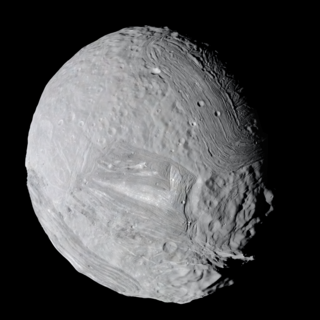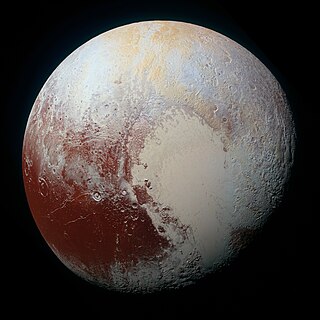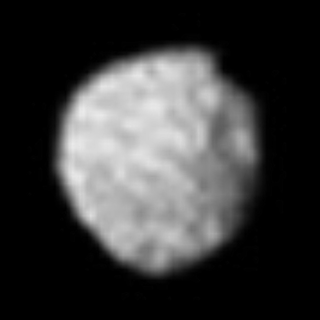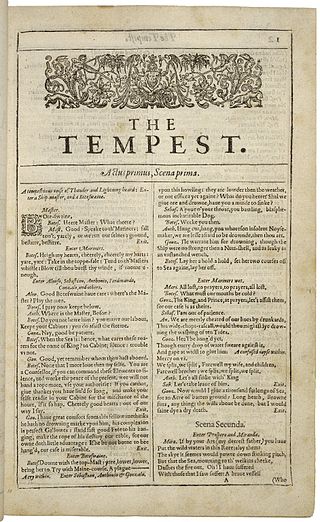
Miranda, also designated Uranus V, is the smallest and innermost of Uranus's five round satellites. It was discovered by Gerard Kuiper on 16 February 1948 at McDonald Observatory in Texas, and named after Miranda from William Shakespeare's play The Tempest. Like the other large moons of Uranus, Miranda orbits close to its planet's equatorial plane. Because Uranus orbits the Sun on its side, Miranda's orbit is nearly perpendicular to the ecliptic and shares Uranus's extreme seasonal cycle.

Planetary nomenclature, like terrestrial nomenclature, is a system of uniquely identifying features on the surface of a planet or natural satellite so that the features can be easily located, described, and discussed. Since the invention of the telescope, astronomers have given names to the surface features they have discerned, especially on the Moon and Mars. To found an authority on planetary nomenclature, the International Astronomical Union (IAU) was organized in 1919 to designate and standardize names for features on Solar System bodies.

Umbriel is the third-largest moon of Uranus. It was discovered on October 24, 1851, by William Lassell. It was discovered at the same time as Ariel and named after a character in Alexander Pope's 1712 poem The Rape of the Lock. Umbriel consists mainly of ice with a substantial fraction of rock, and may be differentiated into a rocky core and an icy mantle. The surface is the darkest among Uranian moons, and appears to have been shaped primarily by impacts. However, the presence of canyons suggests early endogenic processes, and the moon may have undergone an early endogenically driven resurfacing event that obliterated its older surface.

Puck the sixth-largest moon of Uranus. It was discovered in December 1985 by the Voyager 2 spacecraft. The name Puck follows the convention of naming Uranus's moons after characters from Shakespeare. The orbit of Puck lies between the rings of Uranus and the first of Uranus's large moons, Miranda. Puck is approximately spherical in shape and has diameter of about 162 km. It has a dark, heavily cratered surface, which shows spectral signs of water ice.

Titania, also designated Uranus III, is the largest of the moons of Uranus. At a diameter of 1,578 kilometres (981 mi) it is the eighth largest moon in the Solar System, with a surface area comparable to that of Australia. Discovered by William Herschel in 1787, it is named after the queen of the fairies in Shakespeare's A Midsummer Night's Dream. Its orbit lies inside Uranus's magnetosphere.

Ariel is the fourth-largest moon of Uranus. Ariel orbits and rotates in the equatorial plane of Uranus, which is almost perpendicular to the orbit of Uranus and so has an extreme seasonal cycle.
William Shakespeare (1564–1616) was an English playwright and poet.

The Shakespeare quadrangle is a region of Mercury running from 90 to 180° longitude and 20 to 70° latitude. It is also called Caduceata.

The Mock Tempest, or the Enchanted Castle is a Restoration era stage play, a parody by Thomas Duffet; it premiered in 1674, and was first printed in 1675 by the bookseller William Cademan. In creating his farce, Duffet's target was not Shakespeare's famous play, but the adaptation of it that John Dryden and Sir William Davenant wrote in the 1660s. According to critic Michael West, "There are frequent nautical metaphors, and 'more noyse and terrour than a Tempest at Sea'...."
Ferdinand is the prince of Naples and the son of Alonso, the King of Naples, in Shakespeare's play, The Tempest. He falls in love with Miranda. He is quick to promise the title of queen and wife to Miranda even though he doesn't know her name. He is happy in humble labours, blinded by love. He makes a solemn vow to be truthful to Prospero, and not to violate Miranda's chastity before their wedding.

The Messina Chasmata are the largest canyon or system of canyons on the surface of the Uranian moon Titania, named after a location in William Shakespeare's comedy Much Ado About Nothing. The 1,492 km (927 mi)- long feature includes two normal faults running NW–SE, which bound a down-dropped crustal block forming a structure called a graben. The graben cuts impact craters, which probably means that it was formed at a relatively late stage of the moon's evolution, when the interior of Titania expanded and its ice crust cracked as a result. The Messina Chasmata have only a few superimposed craters, which also implies being relatively young. The feature was first imaged by Voyager 2 in January 1986.

The Tempest is a play by William Shakespeare, probably written in 1610–1611, and thought to be one of the last plays that he wrote alone. After the first scene, which takes place on a ship at sea during a tempest, the rest of the story is set on a remote island, where Prospero, a complex and contradictory character, lives with his daughter Miranda, and his two servants: Caliban, a savage monster figure, and Ariel, an airy spirit. The play contains music and songs that evoke the spirit of enchantment on the island. It explores many themes, including magic, betrayal, revenge, and family. In Act IV, a wedding masque serves as a play-within-a-play, and contributes spectacle, allegory, and elevated language.

Gibran is a crater on Mercury and is in the east of the Shakespeare quadrangle. It was named after Lebanese-American poet Khalil Gibran in 2009. Gibran is located east of the rayed crater of Degas and nearby Damer.

Rousillon Rupes is a scarp on the surface of the Uranian moon Titania named after "Bertram, count of Rousillon" in William Shakespeare's comedy All's Well That Ends Well. The 402 km long feature is a normal fault situated near the equator and running perpendicular to it. The scarp cuts impact craters, which probably means that it was formed at a relatively late stage of moon's evolution, when the interior of Titania expanded and its ice crust cracked as a result. Rousillon Rupes has only few crater superimposed on it, which also implies its relatively young age. The scarp was first imaged by Voyager 2 spacecraft in January 1986.

The geological history of Mars follows the physical evolution of Mars as substantiated by observations, indirect and direct measurements, and various inference techniques. Methods dating back to 17th-century techniques developed by Nicholas Steno, including the so-called law of superposition and stratigraphy, used to estimate the geological histories of Earth and the Moon, are being actively applied to the data available from several Martian observational and measurement resources. These include landers, orbiting platforms, Earth-based observations, and Martian meteorites.

Shakespeare is a feature on Earth's Moon, a crater in Taurus–Littrow valley. Astronauts Eugene Cernan and Harrison Schmitt landed southwest of it in 1972, on the Apollo 17 mission. They did not visit it, but in fact drove around it during EVA 3.

Alonso is a crater in the southern hemisphere of Miranda, a moon of Uranus, located at 44° S, 352.6 ° E. It has a diameter of 25 kilometres (16 mi). The crater is named after Alonso, King of Naples, one of the characters in Shakespeare's The Tempest.